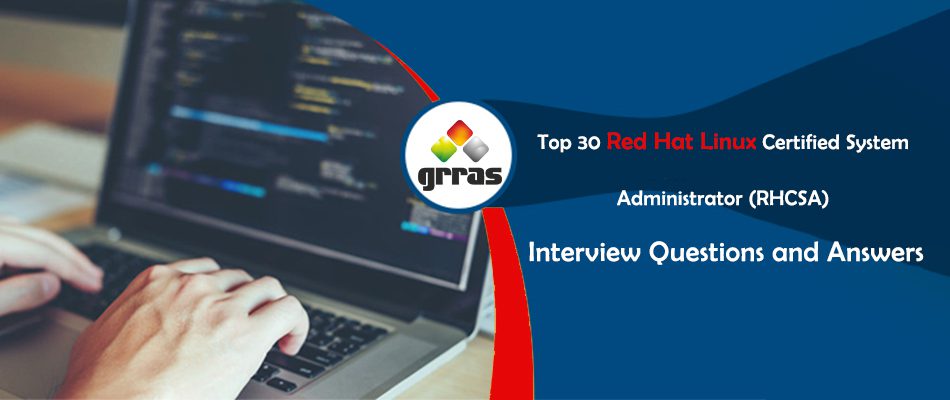Every training and certification course is undertaken with the purpose of getting a job that will help you become an expert in the field. After all, it is with the right job that you will get an easy and comfortable living.
This blog brings to you the top 30 Red Hat Linux Certified System Administrator (RHCSA) interview questions and answers, because we want you to succeed in your life. With this additional information, we are certain that there is no interview that you will not be able to crack and no job will be just a dream to you!
Question 1. How many primary components does Linux system have?
Answer. Linux system primarily has three components namely Kernel, System Libraries, and System Utility.
Question 2. What service that acts as both an FTP and web server should be disabled on a Linux server?
Answer. The one service that should be disabled on a Linux server is finger service.
Question 3. Explain LILO.
Answer. LILO or Linus Loader is a Linux boot loader. Its purpose is to facilitate loading of Linux into the memory and starting the OS. It is customisable an is a code snippet.
Question 4. What tasks are handled by LILO?
Answer. LILO is in charge of handling many tasks including
- Starting the kernel
- Locating Linux kernel
- Identifying & loading other supporting programs
Question 5. Explain LD_LIBRARY_PATH.
Answer. An environment variable, LD_LIBRARY_PATH is employed to debug a non-standard or a new library. You can also use it to search for new directories but the path needs to be specified.
Question 6. Where are the sar logs stored?
Answer. The sar logs are stored at /var/log/sa/sadd file by default.
Question 7. Can the size of the LVM partition reduced or shrunk?
Answer. Yes, LVM partition size can be reduced by following the below steps –
- Use the ‘unmount’ command to unmount the file system
- Use the ‘resize2fs’ command
- Use the ‘Ivreduce’ command
Question 8. Name the modes used in Network Bonding.
Answer. Following are the modes used in Network Bonding –
- Balance-rr or 0
- Active-backup or 1
- Balance-xor or 2
- Broadcast or 3
- 802.3ad or 4
- Balance-tlb or 5
- Balance-alb or 6
Question 9. How many different kinds of Linux user modes are present?
Answer. Linus user modes are of two types namely GUI (Graphical User Interface) and Command Line.
Question 10. What provides better security – Linux or Windows?
Answer. Linux provides better security than Windows.
Question 11. How will you install RPM packages in Linux?
Answer. The ‘yum’ and ‘rpm’ command is used to install RPM packages in Linux?
Question 12. Can the IP address of a Lan Card be checked?
Answer. Yes, you can check the IP address of a Land Card by using ‘ip address’ and ‘ifconfig’ commands.
Question 13. Explain Initrd.
Answer. Short of Initial Ram Disk, Initrd is the storehouse for temporary root filesystem as well as important modules that facilitate in mounting the original root filesystem in read only mode.
Question 14. Tell us Soft Link is one line.
Answer. Soft link is a method employed for creating shortcuts in Linux. There are a few similarities between soft link and Window’s short cut feature.
Question 15. How can the password of a user be changed from the command line?
Answer. The password of a user can be changed from the command line with ‘passwrd ’.
Question 16. Tell us about SELinux.
Answer. Abbreviation for Security-enhanced Linux, it is a security and an access control implementation feature for Linux kernels. Its purpose is to save the server against compromised daemons and misconfigurations.
Question 17. How can the hostname of a Linux box be determined?
Answer. The hostname of a Linux box can be determined by typing the ‘hostname’ command on the terminal.
Question 18. Tell us about Bootloader.
Answer. It is a program used for booting the OS and helps in determining that from which kernel the OS will be booted.
Question 19. What are run levels and how many are there?
Answer. Run levels are a state of init as well as the whole system that explains the operating system services. These are identified by numbers and there are seven different run levels.
Question 20. How can we determine the version of the red hat?
Answer. The version of the red hat can be determined by using the ‘cat /etc/Redhat-release’ version.
Question 21. Tell us about the storage cluster.
Answer. When multiple computers are combined to perform certain tasks, it is referred to as storage cluster. Some of the major clusters include load balancing, storage, high performance and high availability, including others. It makes the servers better.
Question 22. Which web pages are used while serving web pages while installing Apache?
Answer. While installing Apache, by default the web server Port 80 and hence, it is the most commonly used web server as well. While another port can be used, it will have to be typed into a browser first.
Question 23. Explain the load balancing cluster?
Answer. As can be guessed from the name, a load balancing cluster is used in balancing the load across the cluster nodes. When a cluster dispatches a service request to another cluster node, it gets activated. The collapse of a node is not visible outside the cluster.
The load balancing cluster offers highly inexpensive scalability since many nodes can be configured simultaneously.
Question 24. What does LVM stand for?
Answer. LVM stands for Logical Volume Mangere. It gives way to PV (Physical Volume), which is then combined with VG (Volume Groups) that is then divided into LV (Logical Volumes).
Question 25. What is the ‘parted’ command?
Answer. The ‘parted’ command is used to manage clear and easy disk partitions in the hard disk. This helps highly in extending, shrinking, adding and deleting hard disk partitions as well as file systems.
Question 26. What are the Unix states?
Answer. The four states in Unix are waiting, running, stopped and zombie.
Question 27. What is umask?
Answer. Abbreviation for user file creation mask, it is used in determining the setting of a mask that further manages which file permissions for directories and files upon their creation.
Question 28. What is network bonding?
Answer. The aggregation of various Ian cards together into a single bonded interface for the purpose of providing high performance and fault tolerance is known as network bonding. It is also referred to as NIC Teaming.
Question 29. How can you permanently set the umask for a user?
Answer. In order to permanently set the umask for a user, we need to put in the right profile file that highly depends on the default shell of a particular user.
Question 30. How can default route and routing table be checked?
Answer. In order to check the default route and the routing table, commands such as ‘route-n’, ‘ip route show’ and ‘netstat-nr’ can be used.
Conclusion
In order to become an expert in the field, you need to learn from the very best too. Hence, upon completion of your education, you need to move ahead with the right training institute for learning Linux (RHCSA) and there is none better than Grras Solutions to help you out.
With this blog, you will get to know about the top 30 Red Hat Linux Certified System Administrator (RHCSA) interview questions and answers. While the field is quite big, these are the most commonly asked questions and might make an appearance in your interview too.






